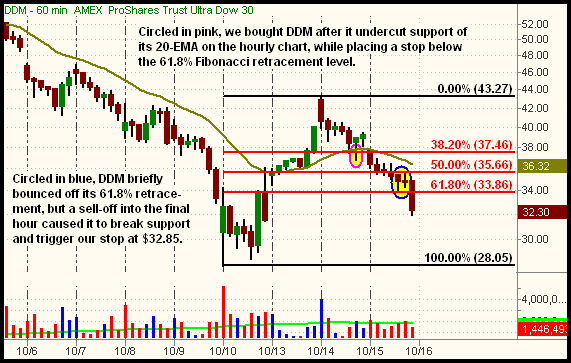|
The Wagner Daily ETF Report For October 16
Stocks followed up Monday's huge rally with a modest pullback on Tuesday, but the bears aggressively resumed control Wednesday, causing the major indices to surrender virtually all of their gains from that record-setting day. Suffering its second worst percentage loss in history, the S&P 500 made like a cliff diver and plunged 9.0%. The Nasdaq Composite similarly plummeted 8.5%, as the Dow Jones Industrial Average tumbled 7.9%. Small and mid-cap stocks fared the worst. The Russell 2000 and S&P Midcap 400 indices belly flopped 9.5% and 9.7% respectively. Returning to their recent bear market habit, all the major indices finished at their dead lows of the day.
Turnover receded across the board, but remained above average levels for the tenth consecutive day. Total volume in the NYSE declined 18%, while volume in the Nasdaq came in 15% below the previous day's level. Market internals, not surprisingly, were among the worst we've seen since the bear market began. In the NYSE, declining volume slaughtered advancing volume by an astronomical margin of 50 to 1! The Nasdaq adv/dec volume ratio was negative by 33 to 1.
Yesterday, we illustrated how we bought Ultra Dow 30 ProShares (DDM) on the afternoon of October 14, when it pulled back to support of its 20-period exponential moving average (EMA) on the hourly chart. Knowing that the market's daily trading ranges have been very wide, we used a looser than usual stop, and lowered our share size to compensate for risk. Specifically, we placed a protective stop about one point below the 61.8% Fibonacci retracement from the October 10 intraday low to the October 14 intraday high. Nevertheless, DDM sliced right through that support level yesterday, pausing to bounce off it only briefly. On the hourly chart below, we've annotated our entry price, as well as the level where we closed the trade after it broke support:

Circled in blue, notice how DDM initially found support at the 61.8% Fibonacci retracement level, and attempted to reverse its descent for more than an hour. But persistent selling into the close caused DDM to fall to a new intraday low, triggering our stop. Even though the trade resulted in a loss, we still had a sound, technical reason for entry, as well as a logical stop that provided ample "wiggle room." If the October 13 rally was indeed going to be the start of at least a short-term rally, the pullback to the 20-EMA on the hourly chart provided the ideal entry point to buy on a retracement.
Yesterday's losses caused both the Nasdaq Composite and Nasdaq 100 indices to set new, five-year closing lows. The S&P 500 and Dow Jones Industrial Average marginally finished above their October 10 closing prices. With essentially all of the October 13 gains erased, the main stock market indexes are now faced with testing support of their recent lows. If the market still has a chance to form a bottom, these prior lows must hold. However, an intraday dip below the lows would not be shocking.
We concluded yesterday's market analysis by saying, "The ability of the market to retain most of its October 13 gains over the next several days will be a determining factor as to whether that day's gains were a fluke, or the start of a substantial, tradeable bounce. It's definitely too early to predict whether we've seen the ultimate lows of the year-old bear market, but a short to intermediate-term counter-trend rally of at least 2 to 5 weeks is certainly a realistic expectation." Based on yesterday's action, the massive, bear market rally of October 13 could very well have been a powerful fakeout. Still, when markets bottom, it's more of a process than a one-time event. As such, it's not unusual for stocks to fall all the way back to test their prior lows, shaking out the last of the bulls, before finally getting some legs. While we certainly were prepared for such an eventual re-test of the October 10 lows, we expected that to happen a few weeks from now, not just two days after the major indices rallied more than 11%.
Based on the incredible price action of the past four days, we have no choice but to return to the sidelines and wait to see what happens next. Initiating new short positions is tricky, as support of the prior lows could easily trigger another wild buying spree. Conversely, the ferociousness of yesterday's sell-off means it's just as dangerous, perhaps more so, to jump in on the long side of the market here. So, now that we're flat again, it's time to shift into "SOH mode" (sitting on hands). There never could be a truer time to say cash is king, at least in the very near-term.
Open ETF positions:
Long - (none)
Short - (none)
Deron Wagner is the Founder and Head Trader of both Morpheus Capital LP, a U.S. hedge fund, and Morpheus Trading Group, a trader education firm launched in 2001 that provides daily technical analysis of the leading ETFs and stocks. For a free trial to the full version of The Wagner Daily or to learn about Wagner's other services, visit MorpheusTrading.com or send an e-mail to deron@morpheustrading.com.
|